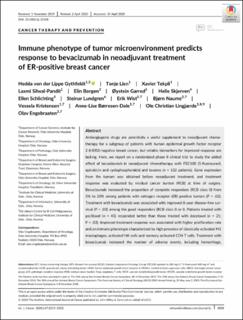| dc.contributor.author | Gythfeldt, Hedda von der Lippe | |
| dc.contributor.author | Lien, Tonje Gulbrandsen | |
| dc.contributor.author | Tekpli, Xavier | |
| dc.contributor.author | Silwal-Pandit, Laxmi | |
| dc.contributor.author | Borgen, Elin | |
| dc.contributor.author | Garred, Øystein | |
| dc.contributor.author | Skjerven, Helle | |
| dc.contributor.author | Schlichting, Ellen | |
| dc.contributor.author | Lundgren, Steinar | |
| dc.contributor.author | Wist, Erik | |
| dc.contributor.author | Naume, Bjørn | |
| dc.contributor.author | Kristensen, Vessela N. | |
| dc.contributor.author | Børresen-Dale, Anne-Lise | |
| dc.contributor.author | Lingjærde, Ole Christian | |
| dc.contributor.author | Engebråten, Olav | |
| dc.date.accessioned | 2023-01-04T14:00:02Z | |
| dc.date.available | 2023-01-04T14:00:02Z | |
| dc.date.created | 2020-07-17T10:44:06Z | |
| dc.date.issued | 2020 | |
| dc.identifier.citation | International Journal of Cancer. 2020, 147 (9), 2515-2525. | en_US |
| dc.identifier.issn | 0020-7136 | |
| dc.identifier.uri | https://hdl.handle.net/11250/3041001 | |
| dc.description.abstract | Antiangiogenic drugs are potentially a useful supplement to neoadjuvant chemotherapy for a subgroup of patients with human epidermal growth factor receptor 2 (HER2) negative breast cancer, but reliable biomarkers for improved response are lacking. Here, we report on a randomized phase II clinical trial to study the added effect of bevacizumab in neoadjuvant chemotherapy with FEC100 (5‐fluorouracil, epirubicin and cyclophosphamide) and taxanes (n = 132 patients). Gene expression from the tumors was obtained before neoadjuvant treatment, and treatment response was evaluated by residual cancer burden (RCB) at time of surgery. Bevacizumab increased the proportion of complete responders (RCB class 0) from 5% to 20% among patients with estrogen receptor (ER) positive tumors (P = .02). Treatment with bevacizumab was associated with improved 8‐year disease‐free survival (P = .03) among the good responders (RCB class 0 or I). Patients treated with paclitaxel (n = 45) responded better than those treated with docetaxel (n = 21; P = .03). Improved treatment response was associated with higher proliferation rate and an immune phenotype characterized by high presence of classically activated M1 macrophages, activated NK cells and memory activated CD4 T cells. Treatment with bevacizumab increased the number of adverse events, including hemorrhage, hypertension, infection and febrile neutropenia, but despite this, the ECOG status was not affected. | en_US |
| dc.language.iso | eng | en_US |
| dc.publisher | Wiley | en_US |
| dc.rights | Navngivelse-Ikkekommersiell 4.0 Internasjonal | * |
| dc.rights.uri | http://creativecommons.org/licenses/by-nc/4.0/deed.no | * |
| dc.title | Immune phenotype of tumor microenvironment predicts response to bevacizumab in neoadjuvant treatment of ER-positive breast cancer | en_US |
| dc.type | Peer reviewed | en_US |
| dc.type | Journal article | en_US |
| dc.description.version | publishedVersion | en_US |
| dc.source.pagenumber | 2515-2525 | en_US |
| dc.source.volume | 147 | en_US |
| dc.source.journal | International Journal of Cancer | en_US |
| dc.source.issue | 9 | en_US |
| dc.identifier.doi | 10.1002/ijc.33108 | |
| dc.identifier.cristin | 1819683 | |
| dc.relation.project | Norges forskningsråd: 191436 | en_US |
| cristin.ispublished | true | |
| cristin.fulltext | original | |
| cristin.qualitycode | 2 | |

